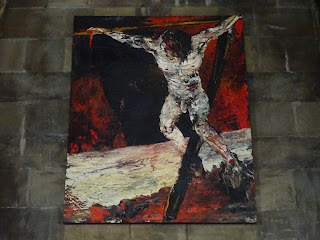'The Priory Church of St Bartholomew the Great contains a number of artworks by notable artists. Some of these are temporary loans, while others are permanent commissions.'
'Damien Hirst's statue of St Bartholomew, known by the title Exquisite Pain is back at St Bartholomew the Great and will be on loan to the church for the next few years. The statue is in the South Transept at the foot of the steps up to the South Doors. The statue is unmissable, but is doubly arresting because it is fully gilded . It grabs your attention even in dim light, and when the sun hits it, the effect is literally dazzling.'
'The artist Sophie Arkette created Colloquy for an exhibition at the Temple Church as a response to the ongoing celebrations of Magna Carta. This remarkable work is now on loan to the Priory Church, and its various parts have been positioned around the building in what is only a first attempt to find the right location for each. The glass elements are etched with text, which is both illuminated and distorted by the effects of light – both from candles that are in some cases lit within the element, and the light from sources around the building – and water, which is also included within parts of the work. Sophie Arkette worked in conjunction with Alan Freeman of Parndon Forge, and Jon Lewis of Orbic Glass in creating Colloquy. The glass etching was undertaken by Norfolk Resists.'
Aude Hérail Jäger's Enmeshed includes 'two large drawings Enmeshed I and Enmeshed II currently on loan at St Bartholomew the Great. Enmeshed illustrates human beings' interwoven-ness with each other and/or their story. The biblical theme of the Lamentation has fascinated Jäger for some years. In ordinary circumstances the group surrounding Christ would argue, plot, come together, fight, shout, laugh, etc. The Lamentation is the one moment when everyone and everything comes to a still-stand around the dead Christ. The figures become welded together and their cluster is the embodiment of grief. Both drawings also encompass recurrent themes in Jäger's work, such as the family and the theme of descending-ascending. In addition they are based on a new working method, which uses observational drawing in National Museums to extract particular aspects from Old Masters' work, which are then appropriated and transformed in large-scale drawings in the studio.'
Also on loan is Richard Harrison's Golgotha; 'rich in colour and texture with generous lashings of paint, which ebb and flow on the canvas reflecting turbulence and ... violent upheaval.' Harrison’s paintings have content which is often 'exaggerated by the vigorous and robust handling of voluminous layers of paint adeptly manipulated to create a dynamic expression of form and colour which resonate all-over the canvas thus underpinning the powerful emotional and visionary themes.'
'Alfredo Roldan was commissioned to paint an altarpiece of the Madonna and Child. In February 1999 it was unveiled in the Lady Chapel and dedicated by the Lord Bishop of London. Roldan aspires to embrace those major Avant-Garde moments of the early 20th century, which has defined his understanding of colour and shaped his application of form and composition. Without apology he acknowledges the influence of Matisse and Picasso and also Modigliani for his elongated portrayal of the female nude. And yet, like all genuine and honest painters who recognise the importance and significance of those historic revolutionary styles, Roldan has assimilated each derivative influence to create his own personal and very distinctive style of painting.'
'Alfredo Roldan was commissioned to paint an altarpiece of the Madonna and Child. In February 1999 it was unveiled in the Lady Chapel and dedicated by the Lord Bishop of London. Roldan aspires to embrace those major Avant-Garde moments of the early 20th century, which has defined his understanding of colour and shaped his application of form and composition. Without apology he acknowledges the influence of Matisse and Picasso and also Modigliani for his elongated portrayal of the female nude. And yet, like all genuine and honest painters who recognise the importance and significance of those historic revolutionary styles, Roldan has assimilated each derivative influence to create his own personal and very distinctive style of painting.'
-----------------------------------------------------------------------------------------------
Paul Mealor - A Tender Light.











No comments:
Post a Comment